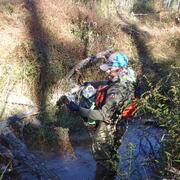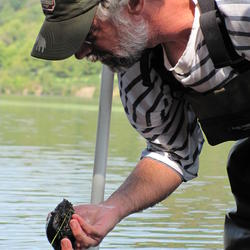Invasive species create risks to ecological communities. Recently, in Puerto Rico, sharptooth walking catfish (Clarias batrachus) were discovered as a new invasive species. This project is using environmental DNA (eDNA) to sample streams and help inform where physical removal efforts of this invasive species could best be allocated.
Amanda Rosenberger, PhD
Amanda is the Assistant Unit Leader of the Tennessee Fisheries CRU. She is from Virginia. Her research interests are in the ecology and conservation of freshwater species, including fish, crayfish, and mussels, with an emphasis on the role of ecological processes in shaping aquatic species' distributions, population characteristics, and community structure.
Research Interests
Amanda's research interests are in the ecology and conservation of freshwater fishes with an emphasis on the role of ecological processes in shaping fish distributions, population characteristics, and community structure. Conservation problems are best addressed at multiple scales; therefore, she is interested in the spatial and temporal dynamics of these patterns at both local and landscape scales. She is particularly interested in investigating mechanistic relationships between fish and physical and biotic features of the environment and how human intervention, nonnative species, and climate change can alter those relationships.
Teaching Interests
- Fish Ecology
- Introduction to Fisheries
- Experiential Learning
- Landscape Ecology
- Community Ecology
Professional Experience
Assistant Unit Leader, Tennessee Cooperative Fishery Research Unit, 2017-
U.S. Forest Service Boise Aquatic Science Lab
University of Alaska Fairbanks
USGS Missouri Cooperative Fisheries and Wildlife Research Unit
Education and Certifications
Ph D Virginia Polytechnic Institute and State University 2003
MS University of Florida 1997
BA Bard College at Simon's Rock 1994
Science and Products
O Romeo! Environmental DNA could prevent a tragedy for the elusive Chucky Madtom
A comprehensive freshwater mussel database for the Duck River Drainage, Tennessee
Environmental DNA reveals invasion of Puerto Rican waterways by non-native Clarias catfish
Environmental DNA (eDNA) surveillance of the federally threatened Slender Chub (Erimystax cahni) in the Clinch River and Powell River
Use of a riverscape-scale model of fundamental physical habitat requirements for freshwater mussels to quantify mussel declines in a mining-contaminated stream: the Big River, Old Lead Belt, Southeast Missouri
Arctic Lake Food Webs
Fatty Acid Signature Data of Potential Yellow-billed Loon Prey in the Arctic Coastal Plain of Alaska, 2009-2011 Fatty Acid Signature Data of Potential Yellow-billed Loon Prey in the Arctic Coastal Plain of Alaska, 2009-2011
Invasive species create risks to ecological communities. Recently, in Puerto Rico, sharptooth walking catfish (Clarias batrachus) were discovered as a new invasive species. This project is using environmental DNA (eDNA) to sample streams and help inform where physical removal efforts of this invasive species could best be allocated.
O Romeo! Environmental DNA could prevent a tragedy for the elusive Chucky Madtom (Noturus crypticus) O Romeo! Environmental DNA could prevent a tragedy for the elusive Chucky Madtom (Noturus crypticus)
Looking for Lazarus: Environmental DNA (eDNA) surveillance of the federally threatened Slender Chub (Erimystax cahini) in the Clinch and Powell Rivers Looking for Lazarus: Environmental DNA (eDNA) surveillance of the federally threatened Slender Chub (Erimystax cahini) in the Clinch and Powell Rivers
A comprehensive freshwater mussel database for the Duck River Drainage, Tennessee A comprehensive freshwater mussel database for the Duck River Drainage, Tennessee
Environmental DNA reveals invasion of Puerto Rican waterways by non-native Clarias catfish Environmental DNA reveals invasion of Puerto Rican waterways by non-native Clarias catfish
Environmental DNA (eDNA) surveillance of the federally threatened Slender Chub (Erimystax cahni) in the Clinch River and Powell River Environmental DNA (eDNA) surveillance of the federally threatened Slender Chub (Erimystax cahni) in the Clinch River and Powell River
Assessing potential habitat for freshwater mussels by transferring a habitat suitability model within the Ozark Ecoregion, Missouri Assessing potential habitat for freshwater mussels by transferring a habitat suitability model within the Ozark Ecoregion, Missouri
An assessment of the relation between metal contaminated sediment and freshwater mussel populations in the Big River, Missouri An assessment of the relation between metal contaminated sediment and freshwater mussel populations in the Big River, Missouri
Increased Population Size of the Federally Endangered Ptychobranchus subtentus in the Wolf River, TN (Fentress and Picket Co.) Increased Population Size of the Federally Endangered Ptychobranchus subtentus in the Wolf River, TN (Fentress and Picket Co.)
Territories within groups: The dynamic competition of drift-feeding juvenile Chinook salmon in 3-dimensional space Territories within groups: The dynamic competition of drift-feeding juvenile Chinook salmon in 3-dimensional space
Use of a riverscape-scale model of fundamental physical habitat requirements for freshwater mussels to quantify mussel declines in a mining-contaminated stream: The Big River, Old Lead Belt, Southeast Missouri Use of a riverscape-scale model of fundamental physical habitat requirements for freshwater mussels to quantify mussel declines in a mining-contaminated stream: The Big River, Old Lead Belt, Southeast Missouri
Multispecies approaches to status assessments in support of endangered species classifications Multispecies approaches to status assessments in support of endangered species classifications
Riverscape-scale modeling of fundamentally suitable habitat for mussel assemblages in an Ozark River system, Missouri Riverscape-scale modeling of fundamentally suitable habitat for mussel assemblages in an Ozark River system, Missouri
Science and Products
O Romeo! Environmental DNA could prevent a tragedy for the elusive Chucky Madtom
A comprehensive freshwater mussel database for the Duck River Drainage, Tennessee
Environmental DNA reveals invasion of Puerto Rican waterways by non-native Clarias catfish
Environmental DNA (eDNA) surveillance of the federally threatened Slender Chub (Erimystax cahni) in the Clinch River and Powell River
Use of a riverscape-scale model of fundamental physical habitat requirements for freshwater mussels to quantify mussel declines in a mining-contaminated stream: the Big River, Old Lead Belt, Southeast Missouri
Arctic Lake Food Webs
Fatty Acid Signature Data of Potential Yellow-billed Loon Prey in the Arctic Coastal Plain of Alaska, 2009-2011 Fatty Acid Signature Data of Potential Yellow-billed Loon Prey in the Arctic Coastal Plain of Alaska, 2009-2011
Invasive species create risks to ecological communities. Recently, in Puerto Rico, sharptooth walking catfish (Clarias batrachus) were discovered as a new invasive species. This project is using environmental DNA (eDNA) to sample streams and help inform where physical removal efforts of this invasive species could best be allocated.
Invasive species create risks to ecological communities. Recently, in Puerto Rico, sharptooth walking catfish (Clarias batrachus) were discovered as a new invasive species. This project is using environmental DNA (eDNA) to sample streams and help inform where physical removal efforts of this invasive species could best be allocated.






